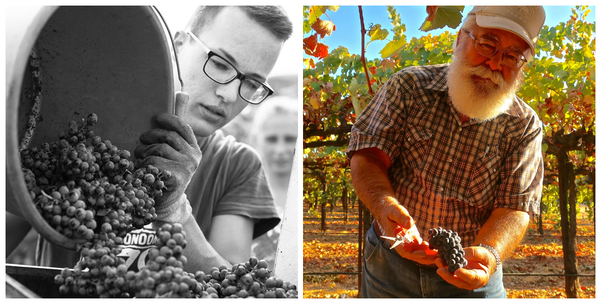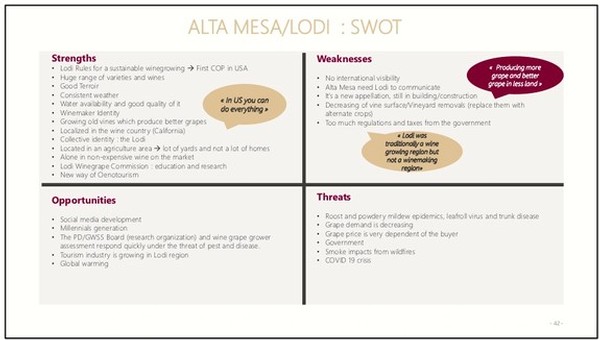Letters from Lodi
An insightful and objective look at viticulture and winemaking from the Lodi
Appellation and the growers and vintners behind these crafts. Told from the
perspective of multi-award winning wine journalist, Randy Caparoso.
French students break down Lodi winegrowing, marketing, and its Alta Mesa appellation

Cabernet Franc grapes (left), emblematic of France's Saumur-Champigny, compared to the Touriga Francesa grape (right), one of over two dozen different varieties grown in Lodi's Alta Mesa AVA
How does the "outside world" look at the wine regions of Lodi, which were almost unknown to the rest of the world up until the 1990s? Or, in fact, not until after the Lodi Winegrape Commission was formed by the region's growers in 1991.
An interesting perspective can be gleaned through an in-depth report recently authored by six students at ESA, France's School of Agriculture. This past December 2020, these French agricultural engineering students, as they describe themselves, contacted the Lodi Winegrape Commission for help in conducting an unusual research assignment: a comparison of France's Saumur-Champigny appellation with Alta Mesa, one of Lodi's seven sub-AVAs (i.e., a federally recognized American Viticultural Area).
Very few American wine consumers, let alone French agricultural engineering students, are even aware of the existence of Lodi's Alta Mesa region. It is a grape-growing zone, not a winery/visitor destination like Napa Valley, or even the area surrounding the City of Lodi that is now replete with wineries, small and big. There are no wineries to visit in Alta Mesa, which falls completely within the boundaries of Sacramento County.
Saumur-Champigny, in turn, is one of France's lesser-known wine regions, located in the Loire Valley and planted primarily to Cabernet Franc (at least 85% of the region's vineyards), Cabernet Sauvignon and an obscure black-skinned grape called Pineau d'Aunis.

The vineyard on rolling hillsides in Saumur-Champigny (top) contrasted with the flat, tabletop-like topography of the vineyard in Lodi's Alta Mesa AVA (below)
Back in the late 1980s, the famous Berkeley importer of French wines, Kermit Lynch, first introduced me to Saumur-Champigny — probably one of the least popular wines in his portfolio because of their unfashionably lean, slightly underripe sensory qualities. It was a Parisian artist/bon vivant, however, who introduced me to the joys of these red wines, which are almost always soft in tannin yet fragrant in berryish fruit, prickly in acidity, yet easy to drink. He always drank it with ice cubes, from a highball glass.
Despite the differences between Alta Mesa-Lodi and Saumur-Champigny, the objective of the ESA students' assignment was to compare and contrast the two region's systems of trade and marketing, their social, economic, and environmental impacts, the dynamics of their "ecotourism," the regions' strengths and weaknesses, and their overall sense of identity.
The result of their research was a detailed 110-page report, largely the result of online research as well as Zoom interviews. Just because of the unusual nature of this report, we're going to share some of the graphics that the six students put together to summarize the points made in their text. The language in the graphics is stilted because they sent over the images with largely computer-generated French-to-English translations, but you should still get the picture. Think of it as a very different, and interesting, set of eyes on Lodi winegrowing in general.
The title page, listing the six authors and declaring their subject matter, the "protected geographical indications" of Saumur-Champigny and Alta Mesa:

First, the geographical location of the two appellations within their larger appellations (respectively, France's Loire Valley and California's Lodi AVA):

This graphic illustrates perhaps the biggest difference between Saumur-Champigny, which was first planted to grapes in the eleventh century, and Alta Mesa, the grape growing history of which is less than 40 years old:

The ESA students, however, were delighted to find that a significant common factor shared by the distant regions was their commitment to "biodiversity," first started up in the 1990s and since becoming "essential," especially with the "rise in consumer mistrust and questioning of agriculture and viticulture":

In contrast to the three grape varieties controlled by French appellation laws (i.e., AOC) dictating what can be grown in Saumur-Champigny, over two dozen varieties are commercially grown in Lodi's Alta Mesa. For this image, the ESA students highlighted three of the grapes grown in Alta Mesa that they found of particular interest because they are "perfect" for the region's warm Mediterranean climate. If Americans ever implemented viticultural laws like the French (which they never would), specifying grapes allowed to be grown, it would be based on the natural suitability of grapes to a region's terroir, as you find in regions like Saumur-Champigny.

"During the research," wrote the students, "the wine promoting scale between Saumur-Champigny and Alta Mesa was different... Saumur-Champigny wines are promoted like Saumur-Champigny wines only and the Loire identity isn't showcased. Alta Mesa wines are mainly promoted under the name of Lodi, sometimes 'Alta Mesa' is added after, only Lodi AVA is written." Which, they added, only "seems logical," since Lodi is the bigger and more "interesting" AVA to promote:


It should not be surprising that the students found that the focal points of Saumur-Champigny marketing are currently on websites, social media outlets, the impact of "influencers" and organized campaigns — exactly the same as in Lodi, and California wines in general:

Bottle shapes and labels in Saumur-Champigny, however, remain very "traditional," whereas "Alta Mesa and Lodi labels are more 'modern'":

In their chapter entitled "The Pedo-Climatic System," the ESA students drilled deeper into the "Natural Components of the Terroir":

Key points found by the ESA students include the fact that Alta Mesa is a "warmer region" and Saumur-Champigny "more mountainous," but both regions "benefit from a favorable climate and rich soils." From the "pedoclimatic" perspective, they found "an influence of the climate as well as the composition of the soil on the typicality of the wines produced":

In their chapter entitled "The Socio-Technical System," the students focused on "Viticultural and Oenological Practices," citing that "the main trend in Saumur-Champigny is to cultivate the vines in a way to respect the environment," which they also found in Lodi:

Despite the commonalities, the students found fundamental differences in how viticultural and vinification practices are actually regulated in Saumur-Champgny vs. Alta Mesa-Lodi, writing: "In France, the wine represents a place, a history, a how-know and a man regrouped under the noun of 'terroir' while in the USA, the wine represents the winemaker or the wine-growers project and personality."

One of the drastic differences cited by the students is the existence of a "federation" in Saumur-Champigny, typical of organizations in other French wine regions which "defend and manage" appellations by regulating everything from how grapes are grown to how they are vinified and packaged. While no such regulatory agencies exist in California wine regions, Lodi growers and vintners are at least supported by their own Lodi Winegrape Commission, funded by grower self-assessments and furnishing research, education, and product promotion:



In their study of the "Social Organisation" of the two regions, the students cited some of the weaknesses of Saumur-Champigny's approach to "ecotourism" such as labor, especially getting "young people" to become interested in the various aspects of the wine industry. They also noted that in Lodi, the labor pool of the "young Hispanic population" is also decreasing, reflecting a "global common situation" of wine regions:

It is interesting that growers and vintners in Saumur-Champigny, as in Lodi, are also reporting "climate change risks" — in their case, "periods of strong frost and disrupting vegetative cycles," increasing the possibility of diminished crops and production. The wines of Saumur-Champigny, known for "good acidity and elegant tannins," are also likely to change, "becoming more fleshy and powerful." While not necessarily undesirable, this would alter the "typology of the wines," which gives Saumur-Champigny its identity. In Lodi, practices such as LODI RULES for Sustainable Winegrowing help to address global warming on a planetary scale:

Based upon their study, this is how the French agricultural engineering students identify the strengths, weaknesses, opportunities, and threats (i.e., "SWOT") of the two contrasting regions:


Despite basic cultural, socioeconomic, and terroir-related differences between Saumur-Champigny and Alta Mesa-Lodi, the students found much in common between the two regions: "The climate of both regions is quite similar even if Alta Mesa is warmer... In general, they invest a lot in environmental preservation with specific measures and innovations even if the problems faced and the vision are different.
"It is important to remember that the USA has really light global regulations about viticulture and winemaking and the growers are free about their practices... Saumur-Champigny already has an identity created by the time and the Lodi/Alta Mesa is just starting to shine."